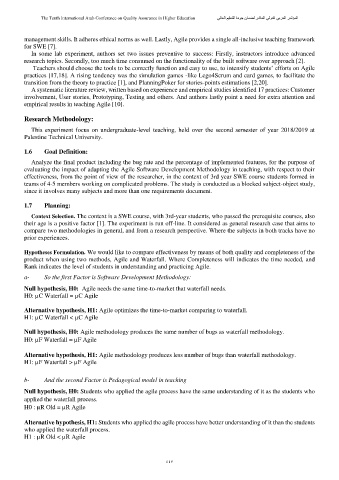Page 468 - confbook2022
P. 468
The Tenth International Arab Conference on Quality Assurance in Higher Education ﻲﻟﺎﻌﻟا ﻢﯿﻠﻌﺘﻟا ةدﻮﺟ نﺎﻤﻀﻟ ﺮﺷﺎﻌﻟا ﻲﻟوﺪﻟا ﻲﺑﺮﻌﻟا ﺮﻤﺗﺆﻤﻟا
management skills. It adheres ethical norms as well. Lastly, Agile provides a single all-inclusive teaching framework
for SWE [7].
In some lab experiment, authors set two issues preventive to success: Firstly, instructors introduce advanced
research topics. Secondly, too much time consumed on the functionality of the built software over approach [2].
Teachers should choose the tools to be correctly function and easy to use, to intensify students’ efforts on Agile
practices [17,18]. A rising tendency was the simulation games -like Lego4Scrum and card games, to facilitate the
transition from the theory to practice [1], and PlanningPoker for stories-points estimations [2,20].
A systematic literature review, written based on experience and empirical studies identified 17 practices: Customer
involvement, User stories, Prototyping, Testing and others. And authors lastly point a need for extra attention and
empirical results in teaching Agile [10].
Research Methodology:
This experiment focus on undergraduate-level teaching, held over the second semester of year 2018/2019 at
Palestine Technical University.
1.6 Goal Definition:
Analyze the final product including the bug rate and the percentage of implemented features, for the purpose of
evaluating the impact of adapting the Agile Software Development Methodology in teaching, with respect to their
effectiveness, from the point of view of the researcher, in the context of 3rd year SWE course students formed in
teams of 4-5 members working on complicated problems. The study is conducted as a blocked subject-object study,
since it involves many subjects and more than one requirements document.
1.7 Planning:
Context Selection. The context is a SWE course, with 3rd-year students, who passed the prerequisite courses, also
their age is a positive factor [1]. The experiment is run off-line. It considered as general research case that aims to
compare two methodologies in general, and from a research perspective. Where the subjects in both tracks have no
prior experiences.
Hypotheses Formulation. We would like to compare effectiveness by means of both quality and completeness of the
product when using two methods, Agile and Waterfall. Where Completeness will indicates the time needed, and
Rank indicates the level of students in understanding and practicing Agile.
a- So the first Factor is Software Development Methodology:
Null hypothesis, H0: Agile needs the same time-to-market that waterfall needs.
H0: µC Waterfall = µC Agile
Alternative hypothesis, H1: Agile optimizes the time-to-market comparing to waterfall.
H1: µC Waterfall < µC Agile
Null hypothesis, H0: Agile methodology produces the same number of bugs as waterfall methodology.
H0: µF Waterfall = µF Agile
Alternative hypothesis, H1: Agile methodology produces less number of bugs than waterfall methodology.
H1: µF Waterfall > µF Agile
b- And the second Factor is Pedagogical model in teaching
Null hypothesis, H0: Students who applied the agile process have the same understanding of it as the students who
applied the waterfall process.
H0 : µR Old = µR Agile
Alternative hypothesis, H1: Students who applied the agile process have better understanding of it than the students
who applied the waterfall process.
H1 : µR Old < µR Agile
٤٤٧

